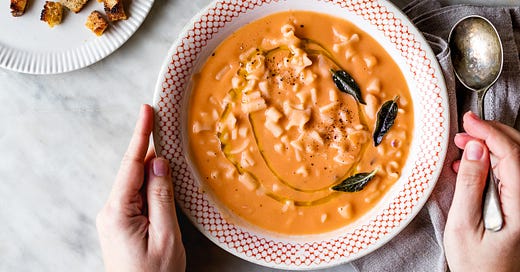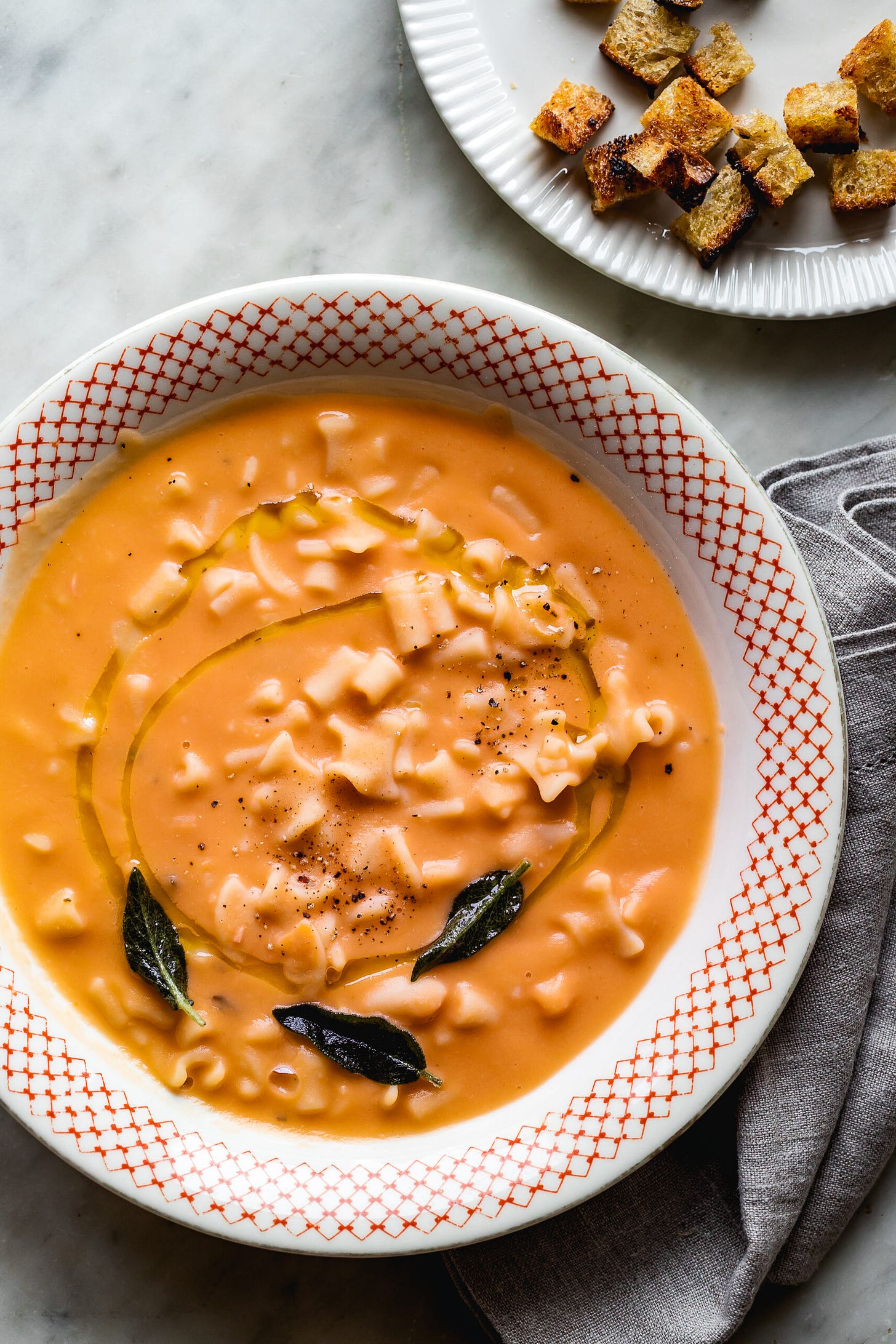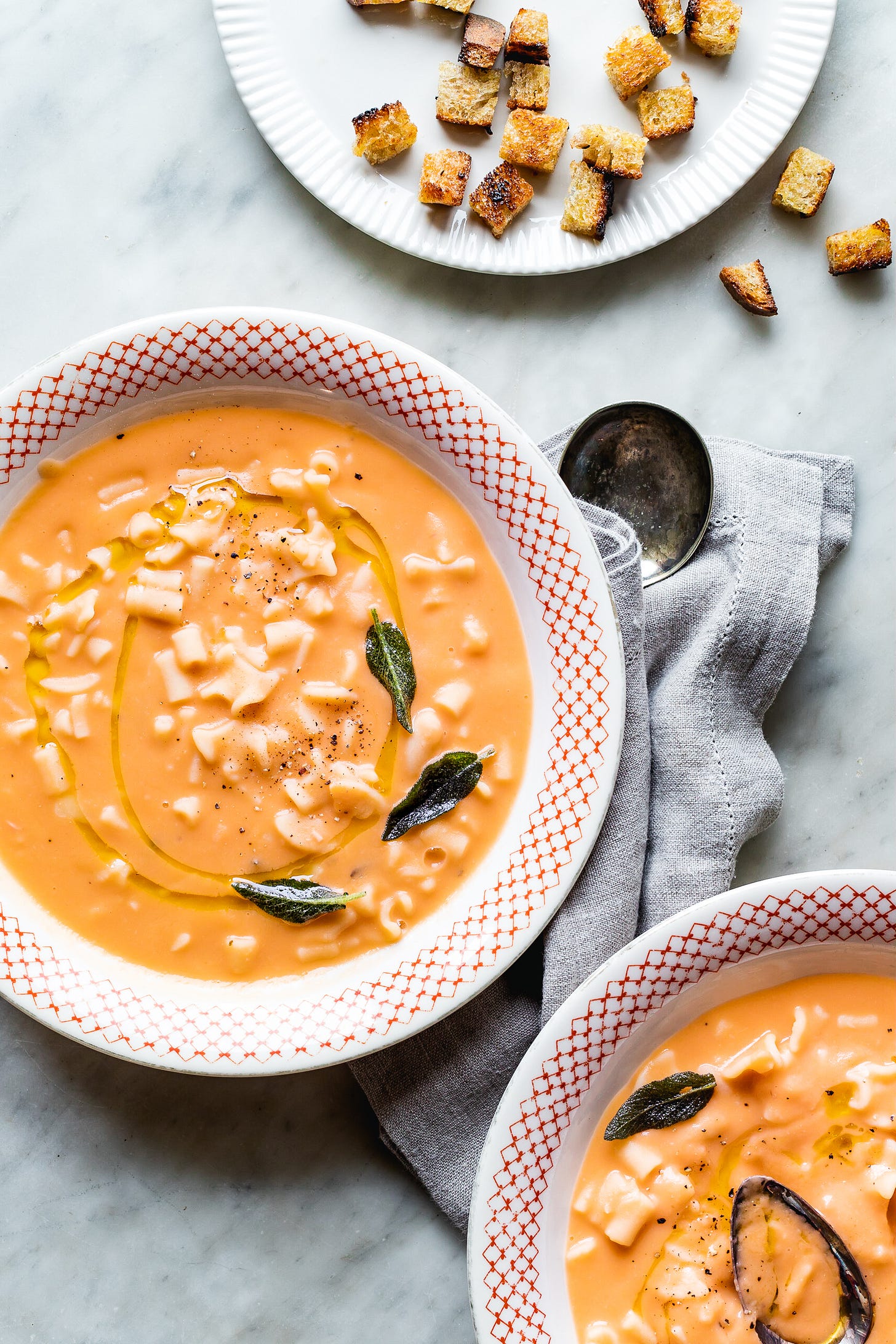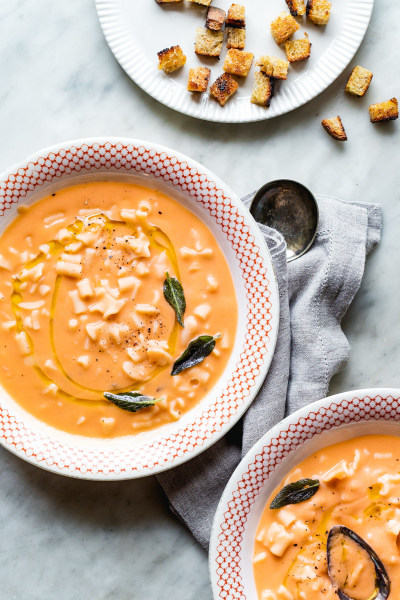giulia's tuscan bean soup with pasta mista
a guest post by giulia scarpaleggia of letters from tuscany and a perfect winter meal
I’m still somewhat new to Substack, but in the few months that I’ve been here, I’ve met some wonderful writers. One of those writers is Giulia Scarpaleggia, six-time cookbook author, recipe developer, teacher, podcaster, and the mastermind behind
, the popular newsletter focused on simple and seasonal Tuscan recipes.Okay, that’s not entirely true—Giulia and I have known each other for a couple of years. We started talking over Instagram, but her blog, Juls’ Kitchen, had already been one of my go-to resources for Italian cooking long before. I love everything Giulia creates. Her writing is so warm and inviting, it almost makes you feel like you’re right there beside her, gazing out across the Tuscan countryside from the window of her gorgeous kitchen studio. I’m honored to share one of her recipes here.
If you haven’t already subscribed to Letters from Tuscany, make sure you do. You’ll not only learn how to make Sienese walnut cookies and spinach and ricotta gnudi (a must for all pasta lovers!), but you’ll also hear about Giulia’s kitchen failures (because we all have them), home renovations, favorite cookbooks, and even what her fellow cooks have in their pantries. Better yet, Giulia’s next cookbook, Cucina Povera, an ode to Italian peasant cooking, comes out in April and is currently available for preorder (click here for details). I was lucky enough to preview the book—make the roasted squash risotto!—and I can’t wait to hold it in my hands this spring. The recipes are perfect for your everyday rotation: simple, healthy, and cheap.
So, without further ado, here’s Giulia’s recipe for a comforting, pasta-filled Tuscan bean soup. I know what I’ll be making this weekend!
Don’t you dare use rosemary in your bean soup
In my family there are unwritten rules about food combinations:
Stuff eggplants with ground meat, bell peppers with rice, and tomatoes with breadcrumbs.
Make sugo di pomodoro (tomato sauce) just with extra virgin olive oil and garlic, while if you’re cooking pomarola (a tomato sauce with plenty of aromatics) onions are allowed.
Cook beans with sage, and chickpeas with rosemary.
Beans and chickpeas are part of the encoded traditions passed down from generation to generation. These rules must be respected. Do not dare cook them differently. Thus, you will find some rosemary needles floating in our passato di ceci (a smooth chickpea purée), while a few crisp sage leaves will match beans and sausages in a traditional winter dish, fagioli all’uccelletto. If you ask my mum why, she will tell you that it has always been like this, and we simply abide by tradition.
Tuscan people really love beans: in every restaurant, from posh ones to cheap ones, from genuine osterias to tourist spots, you’ll find white beans as a side dish, served with a drizzle of good Tuscan extra virgin olive oil. Beans, and pulses in general, are the protagonists of many Tuscan dishes.
My mum’s passato di fagioli, a straightforward puréed bean soup, is good on its own, but it can also be enriched with croutons of toasted bread, rice, farro, barley or pasta, grilled or steamed cod or, in the more refined evening, stir-fried shrimps or prawns with garlic and parsley.
If you have leftover bean soup, you can fill three-quarters of plastic bottles and freeze them. When you will feel like soup, you can just thaw it and warm it with a drizzle of good olive oil.
What to add to your bean soup?
The bean soup is warming and comforting on its own, but if you add a handful of dry pasta, cooked grains, or bread croutons, it becomes a heartier, filling, cosy meal.
Pasta mista
My favourite option is pasta mista. At a domestic level, pasta mista was born to use leftover odds and ends from other pasta shapes: cooking them in a forgiving soup would ensure a perfect final result, even though they could have different cooking times. For the first Neapolitan pasta makers, though, it was a way to sell the broken pieces of spaghetti, maltagliati, or ziti. They would collect the scraps and sell them by weight to those who could not afford to buy the most expensive shapes. Now, even though it is not as common as ditalini, you can find it in supermarkets, too.
If you cannot find pasta mista, make your own pasta mista by mixing the scraps left at the bottom of your pasta drawer, or use ditalini or other similar small, dry pasta for soups.
Cooked rice, barley, farro
This is my mum's favourite option. She follows the batch cooking method even without knowing what it is. Influenced by her old long working days, she usually prepares large pots of bean soup and stores it in the fridge for up to three days, but also in the freezer in handy plastic bottles. She also cooks a large amount of grains - one week she chooses rice, the other farro, or barley - and keeps them in the fridge, too.
When it’s time to serve dinner, she just reheats the bean soup and adds the cooked grains. In less than ten minutes you have a comforting, warming, filling soup on the table.
Bread croutons
These are addictive, so be sure to make them in large quantities, otherwise, they’ll be finished before they reach the table. I, for example, tend to snack on them while I prep dinner. Use whatever day-old bread you have at hand, cube it, and sauté the croutons in a hot pan with a drizzle of olive oil until golden brown. You can finish the croutons with a sprinkle of salt, or add your favourite herbs and spices: if you’re pairing them with the bean soup, my go-to choice is always black pepper and sage.
RECIPE. Passato di fagioli con pasta mista - Tuscan bean soup with pasta
Look at the ingredient list: short, simple, easy to find pantry ingredients. This means a warm, cozy dinner is right behind the corner.
Soaking dry cannellini beans and cooking them long and slow makes a great difference in terms of flavour, also because you could use their cooking water to purée the beans and have and even creamier passato, but if you have a jar of good cannellini beans, go for that.
Serves 4
about 1 lb (500 grams) cooked cannellini beans, cooking liquid reserved
3½ cups (820 ml) bean cooking water, divided
3 tablespoons extra-virgin olive oil, plus more for serving
a handful fresh sage leaves
1 clove garlic, crushed
1 tablespoon tomato paste
5 ounces (140 grams) pasta mista, ditalini, or other small, dry pasta for soups
Fine sea salt
Freshly ground black pepper
Puree the boiled beans with one cup (240 ml) of their cooking water. You can use an electric blender or a classic vegetable mill.
Pour the olive oil into a medium saucepan pot over low heat, then add the crushed clove of garlic and the sage leaves. Cook for a minute until the garlic is golden and fragrant and the sage leaves crisp. Remove the garlic and discard it. Remove the sage leaves and keep them aside as a decoration for the soup.
Now pour into the saucepan the pureed beans and add a tablespoon of tomato paste. Stir well to dissolve it. Taste and adjust the seasoning with salt and pepper.
Bring to a boil, then add the short dry pasta, reduce the heat, and simmer on the lowest flame, stirring often, gradually adding the remaining cooking water. This will make the soup creamier.
Ladle your bean soup into warmed bowls, top it with the reserved fried sage leaves, drizzle each serving with extra-virgin olive oil, sprinkle with freshly ground black pepper, and serve.
Variations
You can make exactly the same soup by substituting beans with chickpeas and omitting the tomato paste. In this case, you’ll have passato di ceci instead of passato di fagioli. And remember: chickpeas call for rosemary, not for sage! Do you know which is the best topping for passato di ceci? Steamed baccalà, or pan-fried shrimps.
If you need to print this recipe to keep it in your kitchen and use for scribbling down your notes, you find the printable PDF below and you can print just odd pages to avoid photos and save ink.
If you make this recipe, share it via email and send me a picture at juls@julskitchen.com, or on Social Media using the hashtags #myseasonaltable #julskitchen and #lettersfromtuscany, and tag @julskitchen
Link Love
Speaking of beans, do not miss this New York Times archive article written by Umberto Eco, a renowned Italian philosopher, on the role of beans in human evolution: How the Bean Saved Civilization.
We believe that the inventions and the discoveries that have changed our lives depend on complex machines. But the fact is, we are still here -- I mean we Europeans, but also those descendants of the Pilgrim Fathers and the Spanish conquistadors -- because of beans. Without beans, the European population would not have doubled within a few centuries, today we would not number in the hundreds of millions and some of us, including even readers of this article, would not exist.












I'm so happy to share this recipe with your readers, it's such a simple, ordinary recipe but so relevant in my family, a classic! Thank you for this opportunity!
Thank you Gulia. I will have to try it soon.